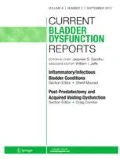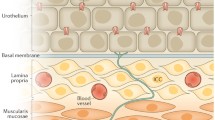Abstract
Ion channels are diverse, ubiquitous membrane proteins in both excitable and nonexcitable cells. Calcium, potassium, sodium, and chloride channels mediate flow of ions across smooth muscle (detrusor, urethra), neural membranes (afferent and efferent axons, terminals, and ganglion cells), and sometimes urothelium. These channels all respond to physiologic stimuli by opening pores gated by ions, changes in membrane potential, G proteins (ligands), and mechanical stimuli. There is substantial interest in the role of ion channels in spontaneous detrusor or afferent activity because new agents to treat overactive bladder and bladder pain syndromes are needed. Repeated injury, mechanical stimuli, and inflammatory cytokines may alter these channels, leading to common voiding disorders and pain. Some individuals may even express isoforms or splice variants of ion channels that predispose them to overactive bladder or pain. This brief overview highlights recent findings relating to ion channels and their potential role in micturition.
Similar content being viewed by others
References and Recommended Reading
Fry CH, Hussain M, McCarthy C, et al.: Recent advances in detrusor muscle function. Scand J Urol Nephrol Suppl 2004, 215:20–25.
McCloskey KD, Anderson UA, Davidson RA, et al.: Comparison of mechanical and electrical activity and interstitial cells of Cajal in urinary bladders from wild-type and W/Wv mice. Br J Pharmacol 2009, 156:273–283.
Andersson KE, Arner A: Urinary bladder contraction and relaxation: physiology and pathophysiology. Physiol Rev 2004, 84:935–986.
Brading AF: Spontaneous activity of lower urinary tract smooth muscles: correlation between ion channels and tissue function. J Physiol 2006, 570:13–22.
McDougall AJ, McLeod JG: Autonomic nervous system function in multiple sclerosis. J Neurol Sci 2003, 215:79–85.
Wegener JW, Schulla V, Lee T-S, et al.: An essential role of Cav1.2 L-type calcium channel for urinary bladder function. FASEB J 2004, 18:1159–1161.
Heppner TJ, Herrera GM, Bonev AD, et al.: Ca2+ sparks and K(Ca) channels: novel mechanisms to relax urinary bladder smooth muscle. Adv Exp Med Biol 2003, 539:347–357.
Li L, Jiang C, Hao P, et al.: Changes in T-type calcium channel and its subtypes in overactive detrusor of the rats with partial bladder outflow obstruction. Neurourol Urodyn 2007, 26:870–878.
Stein R, Hutcheson JC, Krasnopolsky L, et al.: The decompensated detrusor V: molecular correlates of bladder function after reversal of experimental outlet obstruction. J Urol 2001, 166:651–657.
Arner A, Sjuve Scott R, Haase H, et al.: Intracellular calcium in hypertrophic smooth muscle from rat urinary bladder. Scand J Urol Nephrol 2007, 41:270–277.
Meredith AL, Thorneloe KS, Werner ME, et al.: Overactive bladder and incontinence in the absence of the BK large conductance Ca2+-activated K+ channel. J Biol Chem 2004, 279:36746–36752.
Thorneloe KS, Meredith AL, Knorn AM: Urodynamic properties and neurotransmitter dependence of urinary bladder contractility in the BK channel deletion model of overactive bladder. Am J Physiol Renal Physiol 2005, 289:F604–F610.
Herrera GM, Etherton B, Nausch B, et al.: Negative feedback regulation of nerve-mediated contractions by KCa channels in mouse urinary bladder smooth muscle. Am J Physiol Regul Integr Comp Physiol 2005, 289:R402–R409.
Christ GJ, Day NS, Day M, et al.: Injection of ‘naked’ hSlo/pcDNA3 ameliorates detrusor hyperactivity in obstructed rats in vivo. Am J Physiol Regul Integr Comp Physiol 2001, 289:R1699–R1709.
Li L, Jiang C, Song B, et al.: Altered expression of calcium-activated K and Cl channels in detrusor overactivity of rats with partial bladder outlet obstruction. BJU Int 2008, 101:1588–1594.
Ghatta S, Lozinskaya I, Lin Z, et al.: Acetic acid opens large-conductance Ca2+-activated K+ channels in guinea pig detrusor smooth muscle cells. Eur J Pharmacol 2007, 563:203–208.
Darblade B, Behr-Roussel D, Oger S, et al.: Effects of potassium channel modulators on human detrusor smooth muscle myogenic phasic contractile activity: potential therapeutic targets for overactive bladder. Urology 2006, 68:442–448.
Chapple CR: Solifenacin provides effective antimuscarinic therapy for the complete management of overactive bladder. Expert Opin Pharmacother 2006, 7:2421–2434.
Buckner SA, Milicic I, Daz AV, et al.: Spontaneous phasic activity of the pig urinary bladder smooth muscle: characteristics and sensitivity to potassium channel modulators. Br J Pharmacol 2002, 135:639–648.
Baker SA, Hatton WJ, Hennig GW, et al.: Functional role of stretch-dependent potassium/TREK-1 channels in partial bladder outlet obstruction. J Urol 2009 (in press).
Davies AM, Batchelor TJ, Eardley I, Beech DJ: Potassium channel KV alpha1 subunit expression and function in human detrusor muscle. J Urol 2002, 167:1881–1886.
Thorneloe KS, Nelson MT: Properties and molecular basis of the mouse urinary bladder voltage-gated K+ current. J Physiol 2003, 15:65–74.
Argentieri TM, Sheldon JH, Bowlby MR: American Home Products Corporation, assignee. Methods for modulating bladder function. US patent 6,348,486. February 19, 2002.
Elble RC, Ji G, Nehrke K, et al.: Molecular and functional characterization of a murine calcium-activated chloride channel expressed in smooth muscle. J Biol Chem 2002, 277:18586–18591.
Araki I, Du S, Kamiyama M, et al.: Overexpression of epithelial sodium channels in epithelium of human urinary bladder with outlet obstruction. Urology 2004, 64:1255–1260.
Uchida S, Kurosawa S, Fujino Oki T, et al.: Binding activities by propiverine and its N-oxide metabolites of L-type calcium channel antagonist receptors in the rat bladder and brain. Life Sci 2007, 80:2454–2460.
Du S, Araki I, Mikami Y: Amiloride-sensitive ion channels in urinary bladder epithelium involved in mechanosensory transduction by modulating stretch-evoked adenosine triphosphate release. Urology 2007, 69:590–595.
Yoshimura N, Seki S, Novakovic SD, et al.: The involvement of the tetrodotoxin-resistant sodium channel Nav1.8 (PN3/SNS) in a rat model of visceral pain. J Neurosci 2001, 21:8690–8696.
Black JA, Cummins TR, Yoshimura N, et al.: Tetrodotoxin-resistant sodium channels Na(v)1.8/SNS and Na(v)1.9/NaN in afferent neurons innervating urinary bladder in control and spinal cord injured rats. Brain Res 2003, 963:132–138.
Ritter AM, Martin WJ, Thorneloe KS: The voltage-gated sodium channel Nav1.9 is required for inflammation-based urinary bladder dysfunction. Neurosci Lett 2009, 452:28–32.
Su X, Leon LA, Laping NJ: Role of spinal Cav2.2 and Cav2.1 ion channels in bladder nociception. J Urol 2008, 179:2464–2469.
Lashinger ESR, Steiginga MS, Hieble JP, et al.: AMTB, a TRPM8 channel blocker: evidence in rats for activity in overactive bladder and painful bladder syndrome. Am J Physiol Renal Physiol 2008, 295:F803–F810.
Dang K, Bielefeldt K, Gebhart GF: Differential responses of bladder lumbosacral and thoracolumbar dorsal root ganglion neurons to purinergic agonists, protons, and capsaicin. J Neurosci 2005, 25:3973–3984.
Araki I, Du S, Kobayashi H, et al.: Roles of mechanosensitive ion channels in bladder sensory transduction and overactive bladder. Int J Urol 2008, 15:681–687.
Hougaard C, Fraser MO, Chien C, et al.: A positive modulator of K Ca 2 and K Ca 3 channels, 4,5-dichloro-1,3-diethyl-1,3-dihydro-benzoimidazol-2-one (NS4591), inhibits bladder afferent firing in vitro and bladder overactivity in vivo. J Pharmacol Exp Ther 2009, 328:28–39.
Rasband MN, Park EW, Vanderah TW, et al.: Distinct potassium channels on pain-sensing neurons. Proc Natl Acad Sci U S A 2001, 98:13373–13378.
Streng T, Christoph T, Andersson KE: Urodynamic effects of the K+ channel (KCNQ) opener retigabine in freely moving, conscious rats. J Urol 2004, 172:2054–2058.
Burbridge SA, Clare JJ, Cox B, et al.: New uses for potassium channel openers. WO Patent WO1407768. January 11, 2001.
Author information
Authors and Affiliations
Corresponding author
Rights and permissions
About this article
Cite this article
Steers, W.D., Tuttle, J.B. Role of ion channels in bladder function and voiding disorders. Curr Bladder Dysfunct Rep 4, 125–131 (2009). https://doi.org/10.1007/s11884-009-0018-y
Published:
Issue Date:
DOI: https://doi.org/10.1007/s11884-009-0018-y




